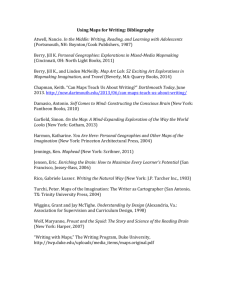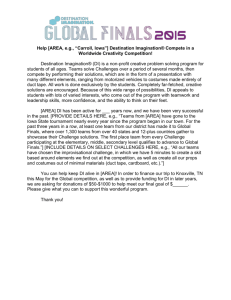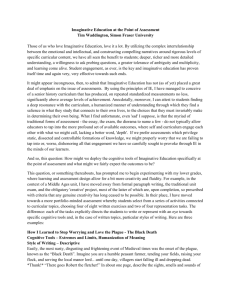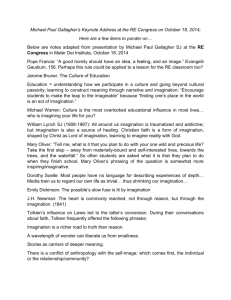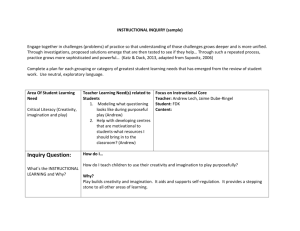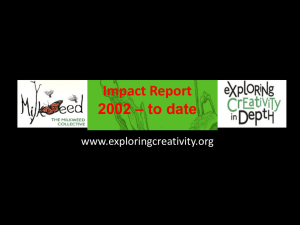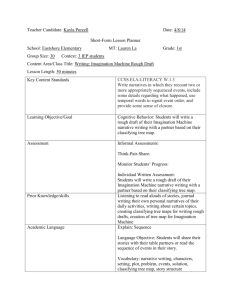clicking here
advertisement
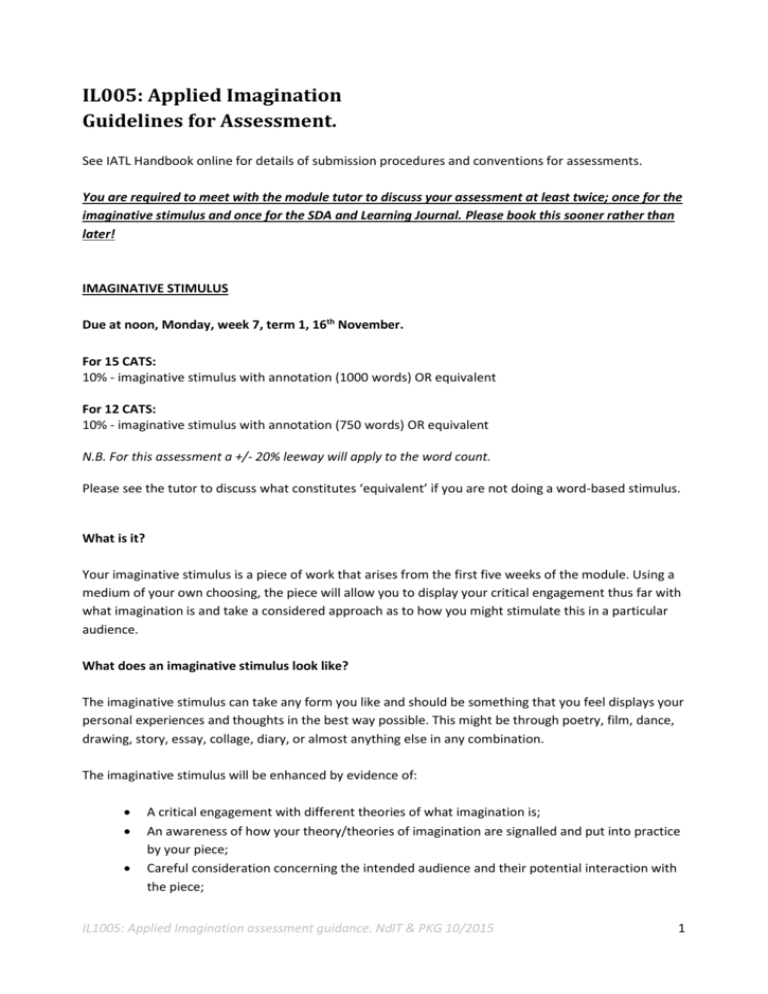
IL005: Applied Imagination Guidelines for Assessment. See IATL Handbook online for details of submission procedures and conventions for assessments. You are required to meet with the module tutor to discuss your assessment at least twice; once for the imaginative stimulus and once for the SDA and Learning Journal. Please book this sooner rather than later! IMAGINATIVE STIMULUS Due at noon, Monday, week 7, term 1, 16th November. For 15 CATS: 10% - imaginative stimulus with annotation (1000 words) OR equivalent For 12 CATS: 10% - imaginative stimulus with annotation (750 words) OR equivalent N.B. For this assessment a +/- 20% leeway will apply to the word count. Please see the tutor to discuss what constitutes ‘equivalent’ if you are not doing a word-based stimulus. What is it? Your imaginative stimulus is a piece of work that arises from the first five weeks of the module. Using a medium of your own choosing, the piece will allow you to display your critical engagement thus far with what imagination is and take a considered approach as to how you might stimulate this in a particular audience. What does an imaginative stimulus look like? The imaginative stimulus can take any form you like and should be something that you feel displays your personal experiences and thoughts in the best way possible. This might be through poetry, film, dance, drawing, story, essay, collage, diary, or almost anything else in any combination. The imaginative stimulus will be enhanced by evidence of: A critical engagement with different theories of what imagination is; An awareness of how your theory/theories of imagination are signalled and put into practice by your piece; Careful consideration concerning the intended audience and their potential interaction with the piece; IL1005: Applied Imagination assessment guidance. NdlT & PKG 10/2015 1 An attempt to make your audience become actively imaginative and assume some autonomy of thought. In other words, your piece does not simply dictate to the audience that something be imagined, they should be prompted to go beyond what they are being immediately presented with; Ultimately, your engagement with theory and ideas is more important than presentation so if you find yourself running out of time then do not get caught up in polishing fine details if they do not add to displaying evidence of the above. How will your imaginative stimulus be assessed? A high mark would be awarded to a piece that has the potential to/does surprise and provoke the target audience into feeling differently or interpreting their experiences in a new way. The piece (and the short annotation, if necessary) would demonstrate an informed awareness as to how and why this reaction could be brought about. It would also display a critical, as opposed to descriptive, engagement with a variety of theoretical positions on what imagination is. A low mark would be given to a piece that places the audience in an unquestionably passive position. It would also show little or no attempt to consider or engage with a specific audience or the question of what imagination is. Although this is a creative task, the 17-point mark scale will broadly apply. Referencing and bibliographies You may choose any academic style of referencing and bibliography layout you wish so long as it is thorough and consistent. The tutor should be able to follow up and check your ideas easily and, where quotations are given, locate that quotation within the referenced material. Bibliographies are required for this assessment. If your piece does not naturally include a place for a bibliography please submit one separately. If you are concerned that you have not obviously expressed where and how your piece has been influenced by material in your bibliography then your bibliography may include short annotations. Any single annotation should be 25 words maximum and read along the lines of: “This work impacted upon my choice to X”, “X’s theory of Y influenced why I included Z”, or “I rejected X’s thinking on Y when I chose to Z”. The purpose of this bibliography and its annotations are to avoid plagiarism and to indicate influence and/or incorporation of ideas. It should not include any further explanation of the influences highlighted or separate argument. Such things must be demonstrated and incorporated into the piece itself and so will not be marked if present in the bibliography. Bibliographies and their annotations do not count towards the overall word count. IL1005: Applied Imagination assessment guidance. NdlT & PKG 10/2015 2 Please speak to the tutor if you are unsure about any of this or have never done a bibliography before. STUDENT DEVISED ASSESSMENT Due at noon, Tuesday, week 1, term 2, 14th January. For 15 CATS: 45% (due term 2) - student-devised assessment (2500-word piece, 15-minute presentation, or equivalent) For 12 CATS: 45% (due term 2) - student-devised assessment (2000-word piece, 12-minute presentation, or equivalent) What is it? Your student devised assessment (SDA) will again be in a medium of your choice. It is your chance to practically express the theories and thoughts you have developed on imagination over the course of the module. It will likely grapple with a particular brief, question, or problem and approach it in an imaginative way. What does an SDA look like? The SDA’s form is, once again, down to you. You should consider what issues and theories you want to address and then pick whatever form you feel best expresses them. We recommend setting yourself some constraints early on in the process. It is advisable to start by thinking of the key question you would like to investigate or explore in your SDA. Discuss the question and the approach you intend to take with one of your tutors in their office hours to ensure your approach will meet the requirements of this assessment. The SDA can be supplemented to some extent by your learning journal and can contain a blurb to help explain some things. However, the blurb must be less than ¼ of the total piece (750 words or equivalent for 15 CATS; 600 words for 12 CATS) and we would encourage you to be creative with this as well. Your SDA will be enhanced by evidence of: A critical engagement with theories concerning the nature of imagination; An awareness of how these theories are embodied in your piece, i.e. the form of your piece needs to have a demonstrable relationship to the ideas behind it; A relationship between the ideas being explored in the SDA and the form it takes. As with the imaginative stimulus, theoretical engagement is more important than presentation. However, this piece comes with a longer time scale for creation so its finish will be expected to be of a high standard. IL1005: Applied Imagination assessment guidance. NdlT & PKG 10/2015 3 How will your SDA be assessed? Although this is a creative task, the 17-point mark scale will broadly apply. A high mark would be gained by a piece that displays a critical reflection on theories of or issues surrounding imagination in a unique and original manner. The piece and any necessary supplementation would show an informed understanding and awareness of these theories and how they are embodied in the piece and would take a considered approach to the relationship between content and form within the assessment. A low mark would be given to a piece that shows little or no engagement with theories concerning imagination or was purely descriptive in its approach to them. A low mark could also be awarded where the form of the piece bears no obvious or explainable relationship to the theories supposedly underlying it. Bibliographies As above, bibliographies are necessary. Also as above, if you are concerned that the influences upon your choice of style or ideas might be missed, you can include annotations so long as they follow the same guidelines as the imaginative stimulus. LEARNING JOURNALS Due at noon, Tuesday, week 1, term 2, 14th January. For 15 CATS: 45% (due term 2) - reflective and critical/analytical journal (2500 words) For 12 CATS: 45% (due term 2) - reflective and critical/analytical journal (2500 words) N.B. For this assessment a +/- 20% leeway will be applied to the word count. What is a Learning journal? A learning journal is an account of your work in progress, but more essentially it is an opportunity for reflection on the learning experience. It should provide you with a means of engaging critically and analytically with the journey made in planning and the delivery of the final assessed workshop. For example, did you experience something in one of the seminars and then try it out? What does a learning journal look like? IL1005: Applied Imagination assessment guidance. NdlT & PKG 10/2015 4 There is no right or wrong way of presenting your journal, as this should take account of personal experience, preferred learning style and your independent research focus. Some journals are electronic (more like video or written blogs), and some take a diary form with visual and written material cut and pasted (literally) into 'scrapbooks'. You should however: Write in the first person. Be mindful that this journal is a public document and therefore it is important to consider the reader as you write. They were not with you on this learning journey so some context is important. Content is more important than presentation. Process and immediacy are the key words. Your journal will be enhanced by evidence of: Progression through a learning journey. Evaluation of new approaches experienced in the period of independent study. Teasing out assumptions underpinning practice Critical evaluation of your own practice. Critical analysis of relevant theory and debates in the Analysis of key or 'critical' moments from independent study, whether positive or negative, and what was learnt from them. Sensitivity to relationships with other members of the group. Taking a position and making an argument from your learning experience. Relevant reading. New understandings made from: reading, planning and or delivery, collaborative activities, the exam, the viva, and the questioning of previous assumptions. How will your learning journal be assessed? Ask yourself is there evidence of: Effective organisation and presentation of material and or evidence. Academic reading used in a relevant way to inform, support and or shape your reflections. Critical engagement with, rather than description of, the creation of your piece, or of the term's work; your own process; and the process of others. Evaluation of the limitations/potential of the work undertaken. Immediacy – did you reflect every time you met for discussions/rehearsals; or after each seminar? The 17-point scale criteria will broadly apply. Please see the IATL Handbook online. A very good journal will be analytical rather than descriptive; selective rather than comprehensive; based in evidence and references to wider reading; critical and cautious in the claims made; personal but not rhetorical. Bibliographies IL1005: Applied Imagination assessment guidance. NdlT & PKG 10/2015 5 As above, bibliographies are necessary. However, annotations would not be expected for the learning journal. Learning Outcomes By the end of the module Applied Imagination students should be able to.... Subject Knowledge and Understanding 1. Understand and use elements of different disciplinary languages 2. Critically evaluate texts and other material with a comparative understanding of different disciplinary processes 3. Recognise the different disciplinary applications of ideas 4. Express complex and transdisciplinary ideas of ‘imagination’ 5. Recognise the complexity of different disciplinary notions of ‘imagination’ 6. Understand the various manifestations of ‘imagination’ in texts and other materials Key Skills 1. Reflect on their own and others’ imaginative processes 2. Communicate with their peers and with academics. 3. Use research tools and resources, including specialist archives, and reference material correctly 4. Articulate arguments orally and through well-argued assignments, supported by wide reading and research 5. Manage time to meet a series of deadlines as an individual and team member 6. Develop collaborative skills (across disciplines) of listening, giving and receiving feedback, and achieving resolution 7. Make productive links between theoretical ideas and practical applications, and appreciate the practical value of learning through workshop performance 8. Solve problems creatively and imaginatively Cognitive Skills 1. Reflect on their own and others’ experiences as participants in an imaginative and interdisciplinary learning process 2. Weigh and compare evidence from historical and contemporary sources in order to make informed but independent judgements 3. Reflect on and contrast different disciplinary models of pedagogy and learning 4. Identify trans- and interdisciplinary issues, formulate questions and engage in problem-solving, including own independent research 5. Synthesise ideas from a range of different disciplinary perspectives 6. Imaginatively respond to dramatic stimuli (texts, films, ideas) to aid individual and group learning and performance Subject-Specific/Professional Skills 1. Decide where and how they might publish their work in academic and non-academic contexts, and present it to a wider audience 2. Appreciate the value of understanding different disciplinary approaches and perspectives, especially in relation to their subject specialism 3. Leverage a confidence and competence in interdisciplinarity for further study, work and citizenship IL1005: Applied Imagination assessment guidance. NdlT & PKG 10/2015 6 Learning Outcomes By the end of the module Applied Imagination students should be able to.... 4. Understand how to apply the theories of imagination to their own work and practices. IL1005: Applied Imagination assessment guidance. NdlT & PKG 10/2015 7
